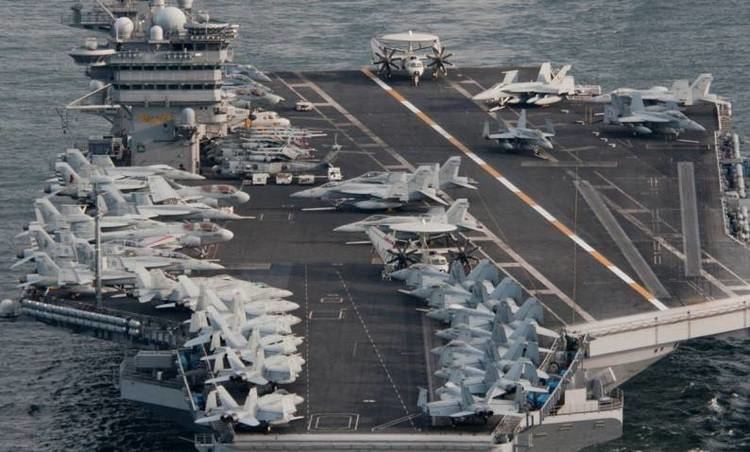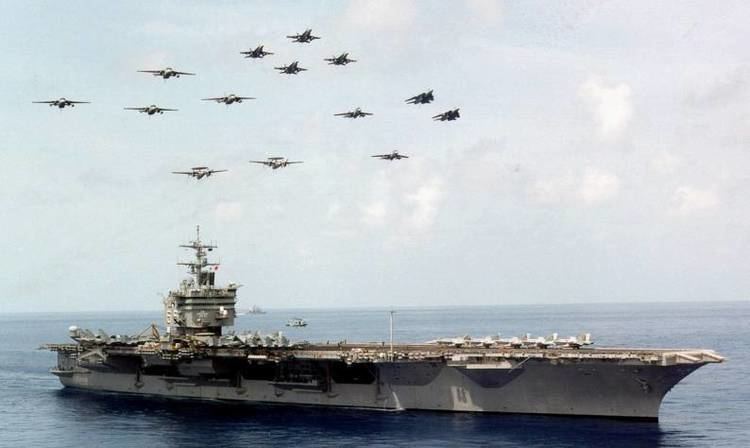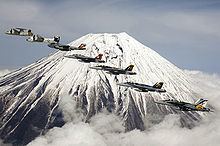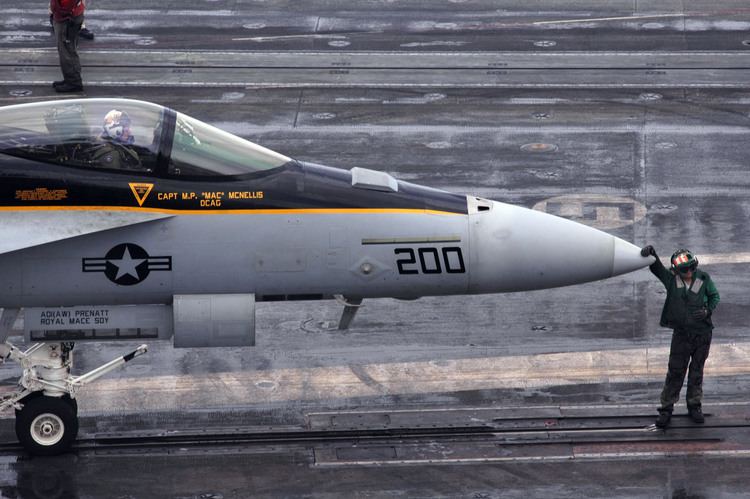 | ||
Carrier air wing cvw 8 homecoming
A carrier air wing (abbreviated CVW) is an operational naval aviation organization composed of several aircraft squadrons and detachments of various types of fixed wing and rotary wing aircraft. Organized, equipped and trained to conduct modern US Navy carrier air operations while embarked aboard aircraft carriers, the various squadrons in an air wing have different, complementary (and sometimes overlapping) missions, and provide most of the striking power and electronic warfare capabilities of a carrier battle group (CVBG). While the CVBG term is still used by other nations, the CVBG in US parlance is now known as a carrier strike group (CSG).
Contents
- Carrier air wing cvw 8 homecoming
- Origins
- Carrier Air GroupCarrier Air Wing Commander
- World War II
- Korea and Cold War 19501953
- Vietnam 19641973 and Cold War 19591973
- Cold War 19741990 and the 1983 Invasion of Grenada
- 1991 Gulf War and Post Cold War 19922000
- 2003 Iraq War
- Current Carrier Air Wing
- Active Carrier Air Wings and identification
- References

Until 1963, Carrier Air Wings were known as Carrier Air Groups (CAGs). Carrier Air Wings are what the United States Air Force would call "composite" wings, and should not be confused with U.S. Navy Type Wings (such as Strike Fighter Wing Atlantic), which are primarily administrative and training commands composed of squadrons of the same type of carrier-based aircraft when not deployed. The United States Marine Corps equivalent command-level organization to a CVW is the Marine Aircraft Group (MAG). However, MAGs are shore-based (with sea-based capability) and may contain any combination of aircraft squadrons and aviation support units. Carrier Air Wings integrate closely with their assigned aircraft carriers, forming a "carrier/air wing team" that trains and deploys together. There are currently ten U.S. Navy Carrier Air Wings, four based at NAS Oceana, Virginia, five based at NAS Lemoore, California, and one forward deployed to NAF Atsugi, Japan. In 2017 the air wing at NAF Atsugi began a phased move of its fixed wing (VFA, VAQ, VAW) squadrons to Marine Corps Air Station Iwakuni. The move is expected to take place over three years. The air wing's helicopter squadrons (HSC and HSM) will remain at NAF Atsugi.

In addition to aviation squadrons collocated at NAS Oceana and NAS Lemoore, the CONUS-based air wings will also draw additional squadrons from NAS Whidbey Island, Washington; NAS Point Mugu, NAS North Island, and MCAS Miramar in California; NAS Jacksonville, Florida; MCAS Beaufort, South Carolina; MCAS Cherry Point, North Carolina; and NS Norfolk/Chambers Field, Virginia. These air wings are occasionally reassigned to different aircraft carriers based on carrier maintenance schedules. A modern air wing consists of roughly 1,500 personnel and 74-78 aircraft.

Origins

The first Carrier Air Groups (as they were then called) were activated in 1937. From July 1937 to mid-1942, Carrier Air Groups were permanently assigned to and identified by their parent aircraft carrier, and group squadrons were numbered according to the carrier's hull number. For example, the Enterprise Air Group, assigned to USS Enterprise (CV-6), were all numbered "6": Fighting Squadron (VF) 6, Bombing Squadron (VB) 6, etc. From 1942, numerical designation of air groups began, the first being Carrier Air Group 9 (CVG-9), established on 1 March 1942. For a while, they were given unique numbers according to their assigned carriers' hull number (i.e., the Enterprise Air Group became CAG-6). This numbering scheme was also soon scrapped as carrier groups (now abbreviated CVGs) frequently moved from carrier to carrier. At this point, the carrier groups simply retained their number designation regardless of the carrier assigned.

The first formal system for air group identification (Visual Identification System for Naval Aircraft) was established in January 1945. This consisted of geometric symbols that identified the parent carrier, not the air group. As there were just too many carriers and the symbols were hard to remember or to describe over the radio, a single or double letter system was introduced in July 1945. The letters, however, still identified the carrier, not the air group. The following identifications are known:

Shangri-La is known to have had her hull number "38" on the flight deck forward replaced by her air group identification letter "Z". Due to the ongoing combat and the end of the war, a mix of identification codes was used in late 1945. Starting in late 1946, the letters identified the carrier air group, and not the carrier. The use of single letters was discontinued in 1957.
On 15 November 1946, to correct the results of demobilization which had left squadron numbers all out of sequence, sweeping changes were made in air unit designations. Carrier Air Groups of four types were designated according to their assigned ship, as CVBG for Battle Carrier, CVG for Attack Carrier, CVLG for Light Carrier and CVEG for Escort Carrier. Two years later, on 1 September 1948, all carrier air groups became CVG regardless of their carrier affiliation.
On 20 December 1963, Carrier Air Groups were retitled Wings, and the acronym CVG became CVW. Replacement Air Groups, which were set up in 1958, became Combat Readiness Air Groups on 1 April 1963. Often known by the short titles RAG and CRAG in the respective periods, their designation throughout was RCVG. When Groups became Wings, CRAG became CRAW and RCVG became RCVW.
From 1960 to 1974, the U.S. Navy also operated Carrier Anti-Submarine Air Groups (CVSG). These typically consisted of two fixed-wing anti-submarine squadrons (VS), a helicopter anti-submarine squadron (HS), and two smaller squadrons or squadron detachments of 3-4 aircraft for airborne early warning (VAW) and self-defense (VA, VMA, VSF, VF).
Carrier Air Group/Carrier Air Wing Commander
Initially and during WWII, the commander of the air group (known as the "CAG") was the most senior officer of the embarked squadrons and was expected to personally lead all major strike operations, co-ordinating the attacks of the carrier's fighter, bomber, and torpedo planes in combat. The CAG was a department head of the ship reporting to the carrier's commanding officer.
In 1963 when Carrier Air Groups were retitled Wings, the commander retained the legacy title of "CAG" which continues to this day.
After WWII until 1983, CAGs were typically post-squadron command aviators in the rank of Commander. Though the CAG was in command of the air wing, he functioned as one of the carrier's department heads reporting to the carrier's commanding officer when the wing was embarked. The CAG would typically subsequently promote to Captain and would track to command of a deep draft support vessel followed by command of an aircraft carrier once greater seniority was achieved in the rank of Captain. In 1983, Secretary of the Navy John Lehman elevated the CAG position to the rank of Captain and made the position coequal with the Captain of the aircraft carrier in which the air wing embarked, with both officers reporting directly to the embarked Flag Officer who was Commander of the Carrier Battle Group. During the period of transition when some air wings were still commanded by Commander CAGs and some were commanded by the new Captain CAGs, the new Captain CAGs were referred to as "Super CAG." The term "Super CAG" quickly reverted to the traditional "CAG" once all air wings had made the transition. Later a slightly junior Captain was added as the Deputy CAG (DCAG), with the DCAG assisting the CAG until he/she eventually "fleets up" to the CAG position. This system remains in place today.
A modern carrier air wing has a small command staff consisting of 16-20 officers and approximately 20 enlisted personnel. It is headed by the CAG who is a Navy Captain with an aeronautical designation as a Naval Aviator or Naval Flight Officer. In the decade of the 2000s, the Navy and Marine Corps "cross pollinated" Carrier Air Wings and Marine Aircraft Groups by assigning a Marine Corps Colonel as the commander of one Carrier Air Wing and a Navy Captain as the commander of one Marine Aircraft Group. That practice ceased before the end of the decade.
Second in command is the Deputy Commander (DCAG), also a Navy Captain aviator or NFO, who "fleets up" to the CAG position after about 18 months. Also on the staff are an Operations Officer (typically a Commander or Lieutenant Commander), a number of warfare specialists (typically Lieutenant Commanders or Lieutenants), two Wing Landing Signal Officers, an Intelligence Officer, a Weapons Officer and a Maintenance Officer. The air wing staff is often supplemented with squadron personnel, such as the squadron intelligence officers. The CAG reports to a Rear Admiral in the position of Commander, Carrier Strike Group and is coequal in stature with the Commanding Officer of the aircraft carrier as well as the embarked Destroyer Squadron (DESRON) Commander and the attached guided missile cruiser commanding officer. The CAG serves as the Strike Group's Strike Warfare Commander, responsible for all offensive strike operations (including Tomahawk Missiles). CAGs are typically qualified to fly at least two types of aircraft in the Carrier Air Wing inventory.
World War II
Typical air group composition aboard the Yorktown Class carriers, at the beginning of World War II, consisted of approximately 72 aircraft:
During the course of the war in the Pacific, the compositions of the air groups changed drastically. The scouting squadrons were disestablished by early 1943 and the number of fighter planes was increased continuously. Typically in 1943 an Essex class carrier carried 36 fighters, 36 bombers and 18 torpedo planes.
By the end of WWII, a typical Essex air group was over 100 aircraft, consisting of :
Korea and Cold War (1950–1953)
Carrier Air Groups typically had four fighter squadrons with 58 planes and an attack squadron of 14 planes.
New to the air wings in the Cold War period after Korea and just prior to Vietnam were specialized squadrons or detachments of aircraft for heavy attack/nuclear strike (VAH), photographic reconnaissance (VAP/VFP, RVAH), airborne early warning (VAW), all-weather medium attack (VA), advanced twin-seat fighters (VF), electronic countermeasures (VAQ), and rescue and plane guard helicopters (HU).
Vietnam (1964–1973) and Cold War (1959–1973)
During the Vietnam War, Attack Carrier Air Wings typically consisted of approximately 70 aircraft, including two fighter squadrons and three attack squadrons, plus the special squadrons and detachments (VAW, VAQ, RVAH or VFP, VQ, HC or HS).
In 1965, a typical Carrier Air Wing consisted of:
By the end of the Vietnam War in 1973, a typical air wing consisted of ~90 aircraft:
An anti-submarine air group (CVSG) aboard the Essex-class anti-submarine carriers (CVS) operated five squadrons:
From 1969 to 1977, a number of carrier air wings were disestablished in the post-Vietnam drawdown: Carrier Air Wing 10 on 20 November 1969, Readiness Carrier Air Wing 12 on 1 June 1970, Readiness Carrier Air Wing 4 on 1 July 1970, Carrier Air Wing 16 on 30 June 1971, Carrier Air Wing 21 on 12 December 1975, and Carrier Air Wing 19 on 30 June 1977 along with all of the Anti-Submarine Air Groups which were disestablished by 1974.
Cold War (1974–1990) and the 1983 Invasion of Grenada
In the mid 1970s the Navy decommissioned its Anti-Submarine Aircraft Carriers (CVS) and its Attack Carriers (CVA) were re-designated CV. The VS and HS squadrons of the former Anti-Submarine Air Groups joined the Carrier Air Wings and the HS squadrons, in addition to their Anti-Submarine role, assumed the search and rescue (SAR) and plane guard roles formerly filled by the HC detachments. By the early 1980s, typical air wings were replacing F-4 Phantom IIs with Grumman F-14 Tomcats on Forrestal, Kitty Hawk, Enterprise and Nimitz class carriers and with F/A-18 Hornets onboard Midway class carriers. LTV A-7 Corsair IIs were also being replaced with F/A-18s, while Grumman KA-6D Intruder tankers and A-6E bombers with aerial refueling pods had replaced A-3s as tankers. EA-6B Prowlers had largely replaced EA-3s in the VAQ mission, although detachments of EA-3s from fleet air reconnaissance squadrons (VQ) soldiered on through the late 1980s as ELINT aircraft until replaced by the Lockheed ES-3A Shadow in the carrier-based VQ mission. The North American RA-5C Vigilante was also phased out in January 1980, replaced by F-14 Tomcats with Tactical Air Reconnaissance Pods (TARPS). The typical Carrier Air Wing of this period consisted of the following.
On 1 March 1984, Carrier Air Wing 13 was established. Between 1 October 1985 and 30 September 1989 the wing made three deployments aboard Coral Sea. Carrier Air Wing 10 was re-established on 1 November 1986 for eighteen months, but then disestablished again in March 1988.
1991 Gulf War and Post-Cold War (1992–2000)
The Gulf War marked the largest concentrated use of carrier air wings since World War II. All F-4s had been retired and A-7Es had largely been replaced with F/A-18 Hornets.
From 1991 to 1995, several Type/Model/Series (T/M/S) aircraft were phased out of the active inventory (e.g., Regular Navy and Naval Air Reserve), to include the RF-8G Crusader, the A-7E Corsair II, ES-3A Shadow, SH-3H Sea King and the A-6E and KA-6D Intruder. While some of these retirements were due to obsolescence (RF-8G) or succession by newer aircraft (A-7Es replaced by F/A-18s), others were due strictly to post-Cold War perceived "Peace Dividend" budget measures on the part of certain Secretaries of Defense and the U.S. Congress (e.g., A-6 Intruder), with aircraft that still had useful remaining life being prematurely relegated to retirement. Other T/M/S aircraft saw the number of operational squadrons significantly reduced (e.g., F-14 Tomcat, E-2 Hawkeye) for similar budgetary reasons. During the same period, three more carrier air wings were disestablished: the Atlantic Fleet's Carrier Air Wing 13 on 1 January 1991, followed by Carrier Air Wing 6 on 1 April 1992, and the Pacific Fleet's Carrier Air Wing 15 on 31 March 1995. In addition, the U.S. Naval Reserve's Carrier Air Wing Reserve 30 (CVWR-30) was disestablished on 31 December 1994.
2003 Iraq War
By 2003, A-6s had been retired with their tanking duties being assumed by S-3s, ES-3s had been retired, and older F-14s were being phased out with the FA-18 E/F Super Hornets.
Current Carrier Air Wing
By 2008 the S-3B Vikings had been retired and the VS squadrons deactivated, the HS squadrons were beginning a transition from their Anti-Submarine SH-60F helicopter to the new MH-60S Naval Special Warfare support, Combat Search and Rescue, and Logistics support helicopter and were being re-designated Helicopter Sea Combat (HSC) squadrons. The Navy's other new helicopter at the time, the MH-60S combined and improved the Anti-Submarine and Anti-Surface Warfare capabilities of the old SH-60F and the old SH-60B surface ship based Light Airborne Multi-Purpose System (LAMPS) helicopter and were equipping a new carrier based helicopter squadron called the Helicopter Maritime Strike squadron (HSM). The HSM squadrons ultimately replaced the VS and HS squadrons as the carrier air wing's Anti-Submarine and Anti-Surface Warfare squadron and the VS tanking role was assumed by the airwing Super Hornet squadrons. By the beginning of the 2010s the VAQ squadrons began their transition from the EA-6B to the new EA-18G Growler.
Today's air wing composition is designed to allow for broad striking power hundreds of miles from the carrier's position, while providing defense in depth of the battle group through early warning and detection of airborne, surface and subsurface targets. The current U.S. Navy carrier air wing consists of:
Active Carrier Air Wings and identification
Atlantic Fleet air wings have an "A" as the first letter of their tailcode identification, while those of the Pacific Fleet have an "N". The "A" or "N" is followed by a letter that uniquely identifies the air wing (e.g., CVW-1 aircraft, part of the Atlantic Fleet, have a tail code of "AB").
* The deactivation of Carrier Air Wing 14 was planned for 2012. However, when Congress passed the 2012 National Defense Authorization Act (NDAA) it mandated that the Navy maintain 10 CVWs (of the nominally eleven active carriers (ten active carriers following decommissioning of USS Enterprise in December 2012 until USS Gerald R. Ford is completed and commissioned in 2017), one is nearly always undergoing Refueling and Complex Overhaul and has no air wing assigned). As a result the U.S. Navy directed Pacific Fleet and Naval Air Forces to stop, and reverse the deactivation process for Carrier Air Wing 14 in a memo dated 20 March 2012. CVW-14 has not deployed since 2011 and due to budget restrictions it has not been fully manned or equipped since 2013 and has not been assigned to any carrier. The Navy's FY17 budget request again included deactivation of CVW-14 and the 2017 NDAA authorized "a reduction to nine CVWs until additional deployable CVNs can fully support a 10th CVW, or until 1, October 2025, which ever comes first, at which time the Navy shall again maintain a minimum of 10 CVWs." CVW-14 is expected to be formally deactivated in 2017.
CVW-17 transferred from Atlantic Fleet (with tail code AA) to Pacific Fleet (with tail code NA) in 2012 and was reassigned to USS Carl Vinson. USS Enterprise decommissioned in December 2012 and CVW-1 was reassigned to USS Theodore Roosevelt in 2013 until USS Theodore Roosevelt shifted homeport to San Diego in 2015 at which time CVW-17 shifted to her. CVW-1 has not yet been reassigned to a CVN awaiting the commissioning of USS Gerald R. Ford (CVN-78)
With the inactivation of CVWR-30 in 1994, the single remaining U.S. Navy Reserve Carrier Air Wing was Carrier Air Wing Reserve Twenty (CVWR-20). On 1 April 2007, CVWR-20 was redesignated as Tactical Support Wing (TSW):
